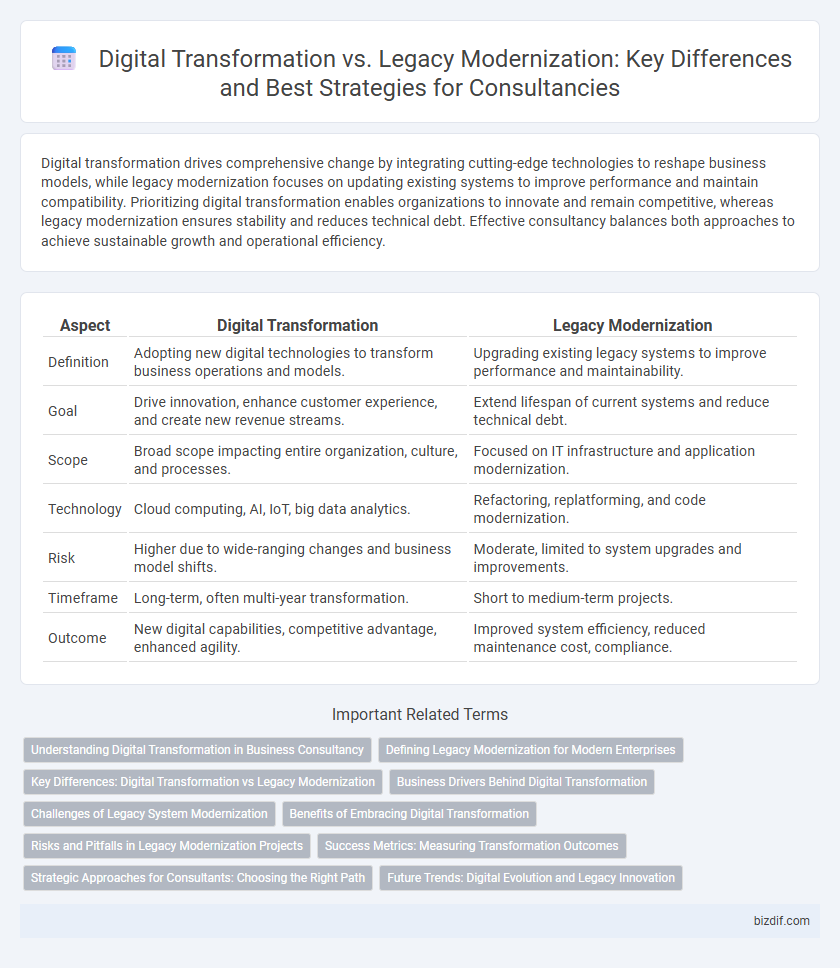Digital transformation drives comprehensive change by integrating cutting-edge technologies to reshape business models, while legacy modernization focuses on updating existing systems to improve performance and maintain compatibility. Prioritizing digital transformation enables organizations to innovate and remain competitive, whereas legacy modernization ensures stability and reduces technical debt. Effective consultancy balances both approaches to achieve sustainable growth and operational efficiency.
Table of Comparison
| Aspect | Digital Transformation | Legacy Modernization |
|---|---|---|
| Definition | Adopting new digital technologies to transform business operations and models. | Upgrading existing legacy systems to improve performance and maintainability. |
| Goal | Drive innovation, enhance customer experience, and create new revenue streams. | Extend lifespan of current systems and reduce technical debt. |
| Scope | Broad scope impacting entire organization, culture, and processes. | Focused on IT infrastructure and application modernization. |
| Technology | Cloud computing, AI, IoT, big data analytics. | Refactoring, replatforming, and code modernization. |
| Risk | Higher due to wide-ranging changes and business model shifts. | Moderate, limited to system upgrades and improvements. |
| Timeframe | Long-term, often multi-year transformation. | Short to medium-term projects. |
| Outcome | New digital capabilities, competitive advantage, enhanced agility. | Improved system efficiency, reduced maintenance cost, compliance. |
Understanding Digital Transformation in Business Consultancy
Digital transformation in business consultancy involves leveraging advanced technologies such as AI, cloud computing, and data analytics to fundamentally change how organizations operate and deliver value to customers. Unlike legacy modernization, which focuses on updating existing systems to improve efficiency and compatibility, digital transformation aims to create new business models and innovate processes for enhanced agility and competitiveness. Effective consultancy in this realm requires a deep understanding of digital ecosystems, change management, and strategic alignment with business goals.
Defining Legacy Modernization for Modern Enterprises
Legacy modernization for modern enterprises involves updating and refactoring outdated IT systems, enabling seamless integration with current digital technologies and cloud infrastructure. This process enhances operational efficiency, reduces maintenance costs, and supports scalability by replacing legacy applications with modular, API-driven solutions. Emphasizing legacy modernization ensures businesses remain agile and competitive in rapidly evolving digital landscapes.
Key Differences: Digital Transformation vs Legacy Modernization
Digital Transformation involves rethinking business models to leverage emerging technologies like AI, cloud computing, and IoT for innovation and competitive advantage. Legacy Modernization focuses on updating or replacing outdated IT systems and applications to improve efficiency, security, and integration without altering core business processes significantly. While Digital Transformation drives strategic change, Legacy Modernization prioritizes technical improvements within existing operational frameworks.
Business Drivers Behind Digital Transformation
Business drivers behind digital transformation include the need for enhanced customer experience, increased operational efficiency, and scalability to support rapid market changes. Digital transformation enables organizations to leverage emerging technologies like AI, cloud computing, and data analytics, differentiating them from legacy modernization, which primarily focuses on updating existing systems to maintain functionality. Embracing digital transformation positions businesses to achieve innovation-led growth and competitive advantage in a fast-evolving digital economy.
Challenges of Legacy System Modernization
Legacy system modernization faces challenges such as data migration complexities, integration with contemporary digital platforms, and ensuring minimal disruption to ongoing operations. Security vulnerabilities and compliance with evolving regulations often complicate modernization efforts. The need for skilled personnel familiar with outdated technologies and resistance to change within organizations further hinder successful digital transformation initiatives.
Benefits of Embracing Digital Transformation
Embracing digital transformation enables businesses to leverage advanced technologies such as cloud computing, AI, and IoT, resulting in increased operational efficiency and enhanced customer experiences. Unlike legacy modernization, which primarily updates existing systems, digital transformation fosters innovation by creating agile, scalable, and data-driven processes. This shift significantly improves competitive advantage and accelerates time-to-market for new products and services.
Risks and Pitfalls in Legacy Modernization Projects
Legacy modernization projects present significant risks including data loss, system downtime, and integration issues that can disrupt business continuity. Misalignment between old and new technologies often leads to compatibility challenges, escalating costs and project delays. Effective risk management requires thorough assessment, stakeholder engagement, and incremental implementation to mitigate pitfalls inherent to legacy modernization efforts.
Success Metrics: Measuring Transformation Outcomes
Success metrics in digital transformation emphasize customer experience enhancements, operational agility, and revenue growth, while legacy modernization success focuses on system reliability, cost reduction, and integration efficiency. Key performance indicators include time-to-market improvements, downtime minimization, and user adoption rates, reflecting the tangible outcomes of modernization efforts. Analyzing these metrics enables consultancies to tailor strategies that maximize return on investment and ensure sustainable business evolution.
Strategic Approaches for Consultants: Choosing the Right Path
Consultants guiding businesses through digital transformation vs legacy modernization must evaluate organizational goals, existing infrastructure, and market dynamics to recommend tailored strategic approaches. Prioritizing digital transformation enables rapid innovation and competitive agility, while legacy modernization focuses on enhancing and securing foundational systems to reduce risk and preserve investments. Effective consultancy involves aligning technology roadmaps with business outcomes, ensuring seamless integration, and optimizing resource allocation for long-term value creation.
Future Trends: Digital Evolution and Legacy Innovation
Digital transformation drives future business success through cloud computing, AI integration, and agile methodologies that promote scalability and innovation. Legacy modernization focuses on updating existing systems with APIs, microservices, and automation to enhance performance and reduce maintenance costs. Combining digital evolution and legacy innovation enables organizations to accelerate time-to-market and maintain competitive advantage in a rapidly changing technological landscape.
Digital Transformation vs Legacy Modernization Infographic

 bizdif.com
bizdif.com